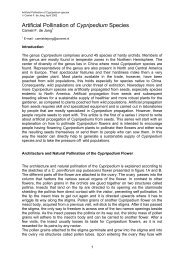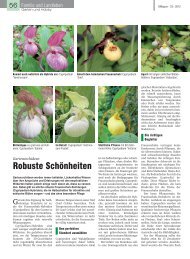Deflasking of Cypripedium seedlings - Cypripedium.de
Deflasking of Cypripedium seedlings - Cypripedium.de
Deflasking of Cypripedium seedlings - Cypripedium.de
Create successful ePaper yourself
Turn your PDF publications into a flip-book with our unique Google optimized e-Paper software.
How to raise in vitro propagated <strong>Cypripedium</strong> <strong>seedlings</strong> to fully established hardy plants for the gar<strong>de</strong>n<br />
© Camiel F. <strong>de</strong> Jong, December 2004<br />
climate in North-Western Europe. In these cases also the prevailing<br />
circumstances are mentioned so the rea<strong>de</strong>r is able to adjust to his or her own<br />
climate.<br />
Dormancy<br />
To survive the cold winter, the shoots <strong>of</strong> <strong>Cypripedium</strong>s die down in autumn after<br />
having produced a new dormant bud. When it’s not freezing, roots continue to<br />
grow whereas the bud stays dormant. The dormancy <strong>of</strong> the bud is only broken<br />
after a three month cold period <strong>of</strong> temperatures below 5ºC ensuring the bud<br />
won’t <strong>de</strong>velop prematurely into a shoot that will freeze to <strong>de</strong>ath during winter. The<br />
extent <strong>of</strong> the required cold period prevents the shoot from growing during warm<br />
spells during winter. In horticulture cold treatment is also applied and is called<br />
vernalization. Vernalization <strong>of</strong> <strong>Cypripedium</strong> <strong>seedlings</strong> is best carried out at 4ºC<br />
during a period <strong>of</strong> three months. Seedlings just out <strong>of</strong> flask have to <strong>de</strong>al with<br />
enough challenges already and should not be subjected to freezing. Although<br />
hardy plants are able to survive freezing, there’s always some damage done that<br />
may ren<strong>de</strong>r the <strong>seedlings</strong> more vulnerable to attack by molds.<br />
If <strong>Cypripedium</strong>s did not have proper vernalization, no shoot will <strong>de</strong>velop. Plants<br />
may survive until next spring and then <strong>de</strong>velop a shoot but it’s most likely they<br />
will perish during summer. Although some species only require a vernalization<br />
period <strong>of</strong> two months it’s best to subject <strong>seedlings</strong> to a vernalization period <strong>of</strong> at<br />
least three months to let the bud <strong>de</strong>velop into a shoot in spring.<br />
Removal <strong>of</strong> <strong>Cypripedium</strong> Seedlings from the Flask<br />
When the <strong>seedlings</strong> have roots with a minimum length <strong>of</strong> around 3 cm and have<br />
visible dormant buds, they are ready to be removed from the flask. If not, let them<br />
grow on to this stage. Seedlings can be <strong>de</strong>flasked until January; after this date<br />
the cold period will become too short, because <strong>seedlings</strong> must be planted out<br />
before, or at latest in April (when only some light frost during night may occur).<br />
The first reason for this is that for strong shoot <strong>de</strong>velopment the <strong>seedlings</strong> seem<br />
to require temperatures below 20ºC. The second reason is that for <strong>de</strong>flasked<br />
<strong>seedlings</strong> to <strong>de</strong>velop their new bud, the growth season must be sufficiently long.<br />
The length <strong>of</strong> the required growth season <strong>de</strong>pends on the species. The more<br />
Northern species such as C. guttatum, C. yatabeanum, and C. passerinum only<br />
require a short growing season but a relatively cold one as well. The species<br />
from warmer climates such as C. fasciolatum and C. kentuckiense need a longer<br />
growing season for proper new bud <strong>de</strong>velopment.<br />
When having reached the proper size, the <strong>seedlings</strong> are carefully removed from<br />
the agar and transferred to a sieve. The plants are then washed with cold water<br />
un<strong>de</strong>r the shower until all agar is removed. The <strong>seedlings</strong> are then transferred to<br />
a clean ziplock plastic bag with a few drops <strong>of</strong> water ad<strong>de</strong>d to it and labeled with<br />
name, date <strong>of</strong> removal from the agar (and the start <strong>of</strong> vernalization!), and number<br />
<strong>of</strong> <strong>seedlings</strong>. At this stage I always take an analogue picture from the bag with<br />
the <strong>seedlings</strong> and the clearly visible label. This will later <strong>de</strong>monstrate that the<br />
2





